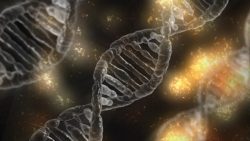 Researchers have developed a new technique for gene therapy by transforming human cells into mass producers of nano sized particles which are full of genetic material. This genetic material has the potential to reverse a variety of disease processes.
Researchers have developed a new technique for gene therapy by transforming human cells into mass producers of nano sized particles which are full of genetic material. This genetic material has the potential to reverse a variety of disease processes.
Although the recent research was initially intended as proof of concept, the experimental therapy slowed down tumor growth and prolonged survival in mice who had gliomas. Gliomas’ constitute close to 80% of malignant brain tumors in humans.
The technique developed takes advantage of exosomes which are fluid filled sacs that cells release as a method to communicate with other cells. While they are gaining ground as biologically friendly carriers of therapeutic materials due to the fact that there is a lot of them and they do not prompt an immune response, the trick with gene therapy is finding a method to fit those comparatively large genetic instructions inside their very tiny bodies on a scale that would have a therapeutic effect.
The newly developed method relies on patented technology that will prompt donated human cells such as adult stem cells to spit out millions of exosomes. After these exosomes are collected and purified, they function as nanocarriers containing a drug. When they are then injected into the bloodstream, they know exactly where to find their target in the body even in the brain.
The team refers to these “gifts” that keep on giving as Mother Nature induced therapeutic nanoparticles.
Previously the team made waves when they released news of a regenerative medicine discovery called tissue nanotransfection or TNT. This technique uses a nanotechnology based chip to deliver biological cargo directly into skin. This is an action that will convert adult cells into any type of cell interest for treatment within a patient’s own body.
Through looking further into the mechanism behind the success of TNT’s, the team discovered that exosomes were the secret to delivering regenerative goods to tissue far below the surface of the skin.
This technology was adapted in the current study into a technique termed cellular nanoporation.
The team placed approximately 1 million donated cells (such as mesenchymal cells which were collected from human fat) on a nano engineered silicon wafer and then used an electrical stimulus to inject synthetic DNA into the donor cells. As a result of the DNA force feeding, the cells need to eject unwanted material as part of DNA transcribed messenger RNA and also repair holes that have been poked in the membranes.
Essentially they fix the leak to the cell membrane and dump garbage out. The garbage they throw out is the exosome. What is expelled from the cell is the drug.
The electrical stimulation had a bonus effect of a thousand fold increase of therapeutic genes in a large number of exosomes released by the cells. This is a sign that the technology is scalable to be able to produce enough nanoparticles for use in humans.
Essential to any gene therapy is knowing which genes need to be delivered to fix a medical problem. The researchers chose to test the results on glioma brain tumors. They delivered a gene known as PTEN which is a cancer suppressor gene. Mutations of PTEN that turn off the suppression role can allow cancer cells to grow unchecked.
Producing the gene is the easy part. The synthetic DNA which is force fed to donor cells is copied into a new molecule which consists of messenger RNA which contains instructions required to produce a specific protein. Every exosome bubble containing messenger RNA is transformed into a nanoparticle which is ready for transport with no blood brain barrier to be concerned about.
The advantage to this is there is no toxicity or nothing to provoke an immune response. Exosomes will go almost everywhere in the body including passing the blood brain barrier. Most drugs cannot go to the brain. They don’t want the exosomes to go the wrong place. They are programmed to not only kill cancer cells, but to know where to go to find cancer cells.
Testing in mice models showed the labeled exosomes were much more likely to travel to the brain tumors and slow their growth compared to substances used as controls. Due to the exosomes safe access to the brain, the drug delivery system has promise for applications in the future for neurological diseases.
It is the hope that one day this can be used for medical needs. The team has provided the method and if somebody knows which kind of gene combination can cure a particular disease but they need a therapy, they have it.
To view the original scientific study click here: Large-scale generation of functional mRNA-encapsulating exosomes via cellular nanoporation





